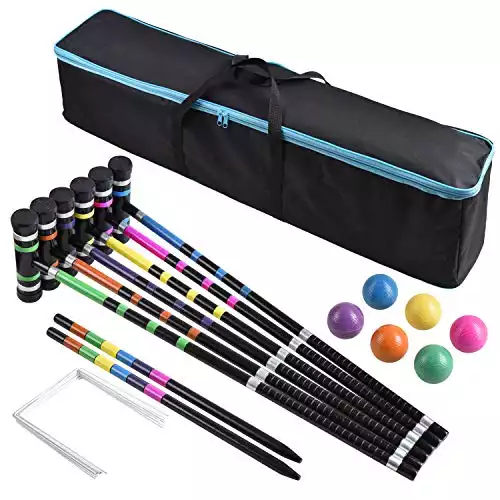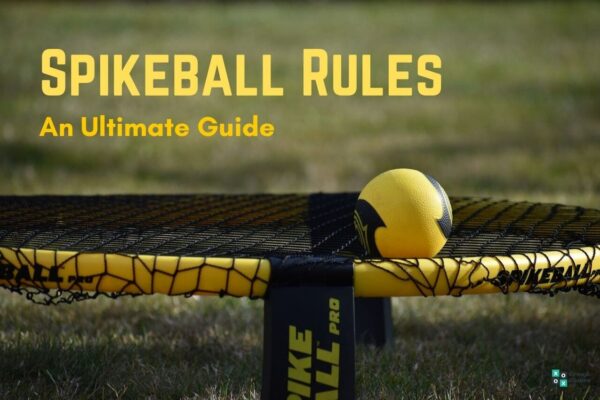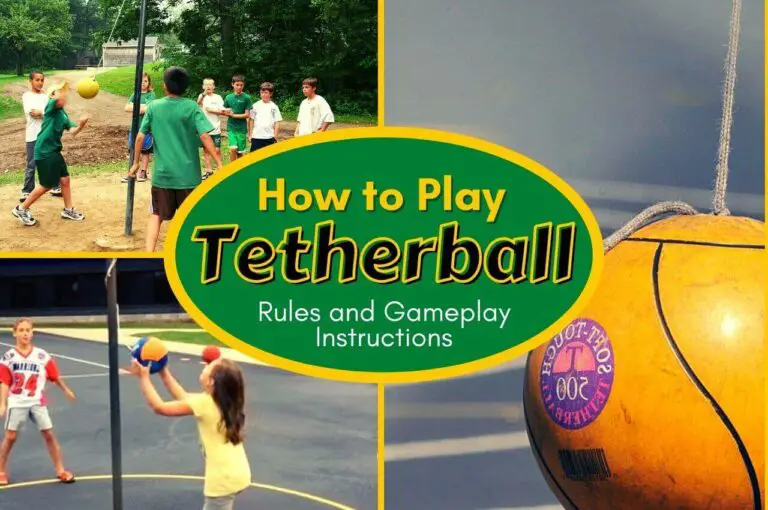Our Backyard Croquet setup and rules will help you learn everything you need to know before starting your first game.
Everyone loves competitive games like Bocce (see Bocce Ball rules) and Molkky because of the thrill it offers. Though they have quite a resemblance to Croquet, these have different rules and unique gameplay.
If you are new to backyard games and unsure if Croquet is the right choice for you, our detailed rules and review of the game will give you an in-depth insight into it.
Related: 5 Best Croquet Sets
What is Backyard Croquet?
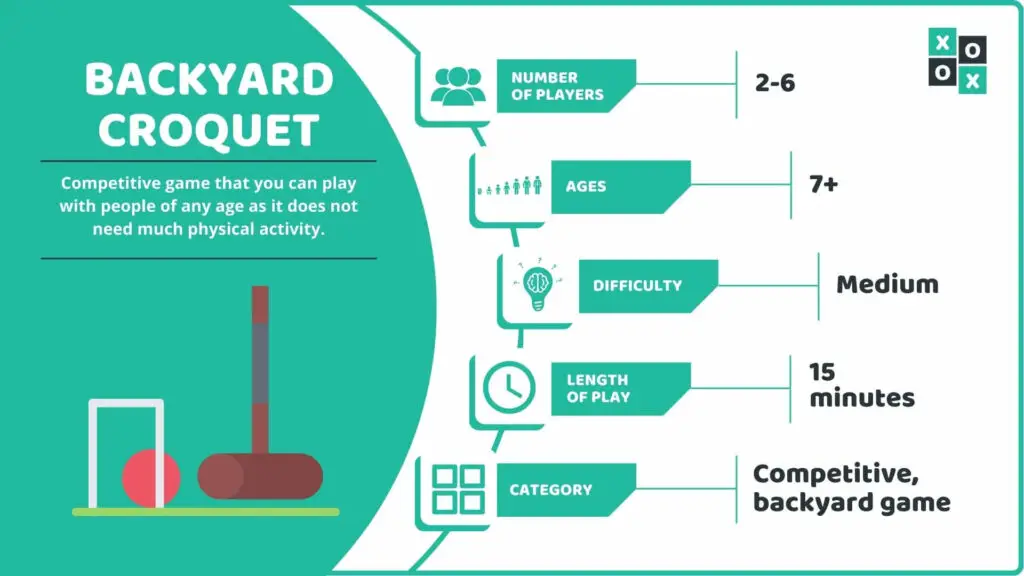
Backyard Croquet is a fun-filled and engaging outdoor sport that you can play on your residential lawn or any other playground. Several variants of Croquet are available, but only a few have gained significant recognition.
You have to make your way through all the wickets while hitting both the stakes. You need to get your ball through a wicket to earn a point, and whoever has the most points at the end of the game wins.
At the start of the game, pick your teams and decide who goes first. In the official 9-wicket croquet, there can be two or more teams of up to six players.
Sometimes, a player can play two balls – making the game more interesting when multiple players are involved.
The World Croquet Federation (WCF) has recognized nine variants of the game, but only Golf Croquet and Association Croquet features in Croquet World Championships.
The variants of Croquet are:
- Association Croquet
- Golf Croquet
- 2-ball Croquet
- Short Croquet
- U.S. 9-wicket Croquet
- U.S. 6-wicket Croquet
- Backyard/ Garden Croquet
- Ancient Croquet
- Extreme Croquet
This croquet setup and gameplay rules will only cover the Backyard or garden Croquet version.
Number of Players: 2 to 6
Ages: 7+
Length: 15 minutes
Difficulty: Medium
Similar to: Bocce, Molkky and Kubb
Main Objective: Try to earn maximum points by passing your ball through the wickets
Why We Love It: Competitive game that you can play with people of any age as it does not need much physical activity.
What You’ll Need to Play Backyard Croquet?
You will need to prepare the court in either a 6-wicket or a 9-wicket layout, six different colored balls, two mallets and two stakes.
For a better experience, grab this premium backyard croquet set, which contains:
- 6 pieces of 35-inch full printed mallets
- 6 colored HDPE balls, 2.8*2.8 inches, 9 oz
- 9 wire-wrapped plastic wickets
- 2 eucalyptus stake post
- 1 600D fabric carrying bag
The product comes with a 45-day money-back guarantee and a two-year product replacement warranty.
Game Setup
The ideal 9-wicket backyard croquet court size is 100*50 inches, but you may adjust these measurements to fit in your garden. Compared to the official 9-wicket, the backyard croquet court is simpler and enjoyable, meant for small family gatherings.
Steps to Set Up A 9-Wicket Backyard Court
Place the stakes and wickets where you think they will end up so that the setup process is more manageable.
If you want an official court size, just double the measurements given below.
- Place a stake at 3 feet from the short side boundary.
- Measure 3 feet from the stake that you just installed and put a wicket in line with it at center court.
- Place another wicket at a distance of 3 feet from the first one, again in line with the stake and center court.
- Place your third wicket at a distance of 16 feet from the second one.
- Again, measure 8 feet from your second wicket towards the third one and measure 9 feet from there towards both sides and place one wicket on each side.
- Measure 16 feet from the third wicket and place the 6th wicket in line with your stake at center court.
- Measure 8 feet from your 6th wicket towards the stake and again measure nine feet from that position on either side and place your 7th and 8th wicket.
- Place your last wicket at a distance of 3 feet from the 6th wicket at center court.
- Place the second stake at a distance of 3 feet from the last wicket at center court.
- Your backyard croquet court is ready for a game.
We would suggest you put flags or something else on the perimeter of your court to determine the boundaries.
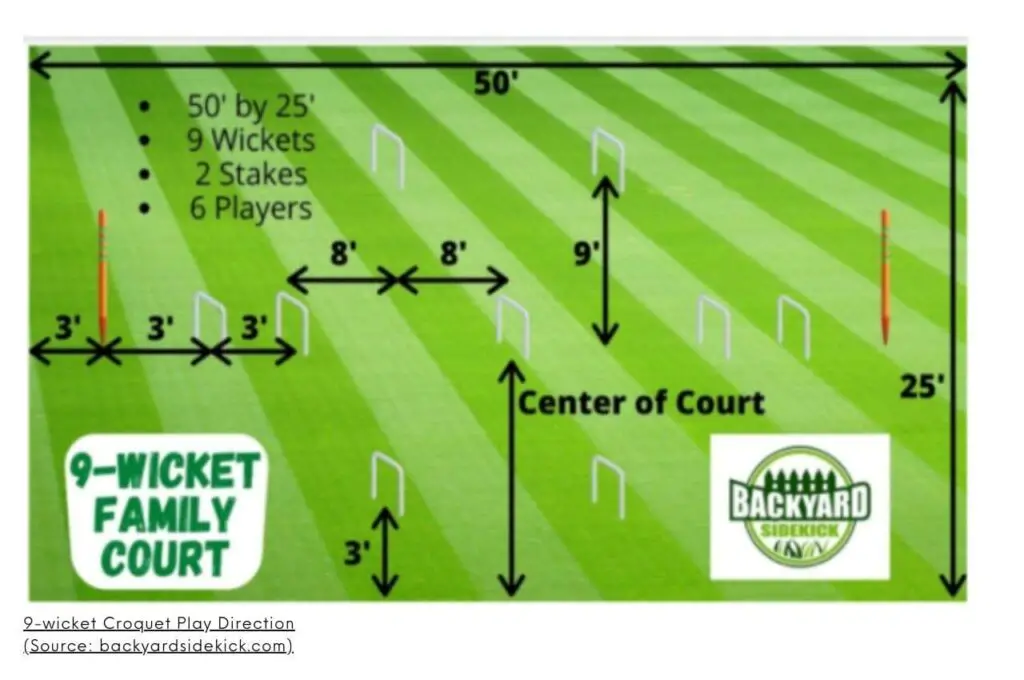
You may end up having some obstacles on your court, but you need not worry about them as it will affect all the players. No one gets any advantage.
Once your court is ready, you can start a game!
Let us get familiar with the official rules of 9-wicket Croquet first, and then we will learn the backyard gameplay.
Order of Play:
- Blue
- Red
- Balck
- Yellow
- Green
- Orange
All the players will start the game with their ball placed between the first stake and the first wicket. Players will get their turn according to the color of their respective balls and order of play.
If you can not decide who gets which color, you may settle it by checking which player can hit a ball closest to the first wicket. Or, you may simply toss a coin to decide.
You should keep in mind that going first is not always the best option. Getting the orange ball may be beneficial as you will get the chance to hit another player’s ball and earn two bonus shots.
Direction of Play
You must know the play direction because you can score a point only if you pass the ball through a wicket in the right direction.
After you reach the second stake crossing all the wickets, you have to go back across the court and hit the first stake.
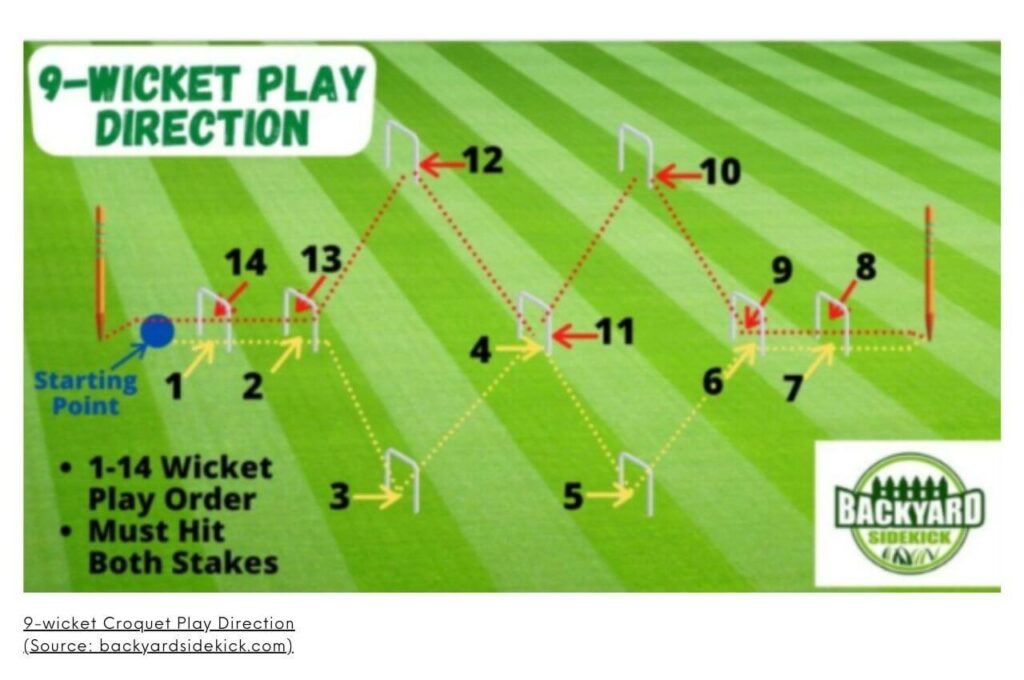
As soon as you are done with the setup, play direction, and selecting your teams, you can start playing backyard croquet.
Backyard Croquet Rules and Gameplay
There are many rules to play croquet, though it may seem difficult to remember all of them at first, yet it is what makes the game so interesting, especially the bonus shots.
Rules
Whoever gets the blue ball will start the game, and each player will get a turn one-by-one. Each turn has a limit of one shot.
- Bonus Shots:
Apart from the allotted hit, you can earn bonus shots. One bonus shot will be awarded for scoring either a wicket or a stake. If you hit another player’s ball, you will earn two bonus shots for that turn. But if a wicket or a stake is scored after hitting some other balls, the player will get only two bonus shots.
- Scoring a wicket:
The ball needs to pass through the wicket bar completely to score a wicket, and you have to wait for the next turn. Even if the ball is partially under a wicket bar, it will not be counted.
Scoring two wickets in the right direction will award you two bonus shots.
- Boundaries:
Generally, croquet boundaries are set by either flag or chalk on the perimeter of the court. Although many people play this game without boundaries in their backyard, boundaries provide some extra fun.
If a player accidentally hits their ball out of the boundary, it shall be placed back to the center court, a mallet-head length away from the boundary.
When a player sends any other ball out of the boundary, it is referred to as a roquet. When a player scores a rocquet there are several options.
The striker may place their ball at a distance of one mallet-head from the ball that has been hit and take the two bonus shots earned.
Or, the player can place their ball touching the other one and hold it with one foot while taking the first bonus shot. Then, the striker may take their second bonus shot.
Another option that the player can choose is to place their ball touching the other one and then take the two bonus shots.
The striker is free to take the two bonus shots from where the ball has landed without any intervention.
- Timed Games:
People do not often play backyard croquet with a time-limit unless there are other teams waiting for their turns. However, the rules of a timed game are somewhat different from a regular game.
In this variant, the time limit is generally set to 10-15 minutes for each player. Each scored wickets and stakes will earn you one point each. The player with maximum points at the end of the game is the winner.
Gameplay
A basic backyard croquet game is played among four people with four different colored balls. Each player gets one ball and takes their strikes respectively in the correct order.
While playing in teams, balls are grouped into two sets.
On your turn, you would want to score a wicket or hit some other player’s balls so that you may earn one or two bonus shots.
At the same time, you will need an effective game plan so that you can reach the final stake first. You can only proceed to the next wicket after you have successfully scored one wicket.
Final Scoring and Winning
There is no point system in a regular game of backyard croquet. It is about achieving the goal before any other player.
The player to get the blue ball will be the first striker. Their objective is to get the ball completely through the wicket. The striker can earn a bonus shot only if he or she scores a wicket as there will be no other ball available to be hit on the court. Otherwise, the next player will come to take the strike.
Players will repeatedly take strikes in the same sequence unless someone scored the final stake and declared the winner.
The players’ ball has to make its way across the court and come back following the correct direction before it can hit the final stake.
You may continue the game after one player has won to decide the runner-up and so on.
How to Play Backyard Croquet – Video Tutorial
Frequently Asked Questions
What is the upper limit of players in Backyard Croquet?
Backyard Croquet can be played among six players at the most. The game is ideal for four players. If there are six players, it is better to divide them into two teams.
How can we earn more than two bonus shots in Backyard Croquet?
Everybody would love to get as many bonus shots as they could, but the game has a restriction of a maximum of two bonus shots in one round. Even if you hit another ball and core a wicket in one strike, you will be only awarded two bonus shots.
Can we play backyard Croquet with fewer wickets?
Yes, you can play backyard croquet with fewer wickets, but it will make the game too easy.
Games Similar to Backyard Croquet
Yard games are fun, and we all love playing them!
If you have liked playing backyard croquet, you may also like Pickleball; its easy and flexible gameplay has made it popular among the masses. A type of paddle sport, it requires players to volley a pickleball in teams. The game demands exceptional strategizing and reflex.
We would also suggest you try Fricket, one of the most loved backyard games ever. Compared to other backyard games, this one brings more challenges. You can make your own Fricket equipment from your household appliances, or you may like to buy an official set.
For more exciting game ideas, you may check our exclusive collection of popular yard games.


